In order for laying hens to produce many eggs and hatch chicks, it is necessary to keep the birds in acceptable conditions. A wooden pen with a concrete floor and a feeder outside is not the best option. Arranging a chicken coop takes time, effort and expense.
Construction features
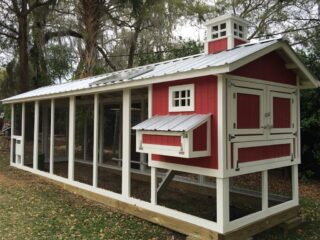
The basic requirements for a poultry house are as follows.
- The norms assume the simultaneous presence of 3-4 individuals per 1 m². Laying hens should move freely around the coop. If there are only two chickens, at least 3 m² is required.
- Birds need walking if they are not free to move around the yard. The dimensions of the compartments are at least 15 m². A canopy is erected over part of the walking area so that the birds have somewhere to hide from the rain.
- It is better to build a chicken coop on a hill in order to avoid dampness and leakage.
- A utility block is built of bricks, foam concrete, cinder blocks. However, wood is the best option, as this material retains heat much better. The brick structure needs serious insulation.
- Windows are placed on the south side to provide natural light. Windows should be openable as the room should be ventilated.
- It is imperative to equip the chicken coop with perches, nests for layers.
The better the chicken coop is, the less often the owner will have to take care of the condition of the chickens.
Internal arrangement of the chicken coop
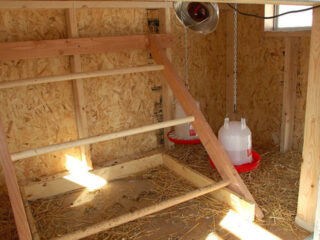
Some structural elements and contents of the poultry house remain unchanged in any way of keeping birds. These include perches, nests, shelves, feeders and other devices.
Perches
The parameters of these devices depend on the breed of chickens.
Laying hens are quite active birds. It is recommended for them to place the roost at a height of 90 cm. You can equip it with a ladder or a board with slats. Broilers are much lazier, they will be perched at a height of 60 cm.
It is better to install perches parallel to each other, at the same height. A rather tough hierarchy reigns in the chicken flock; for the sake of a higher perch, not only young roosters, but also hens will fight.
Each bird should have a 35 cm pole.
A roost is installed opposite the window, preferably near the warmest wall.
Perches are made of bars, even knots and branches with a diameter of 4–5 cm, shovel cuttings. If you take a bar, be sure to round off the corners with a plane.
Nests
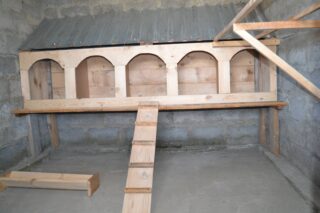
An indispensable element of arranging a country chicken coop is a nest. They are put not only specifically for laying hens, but also for meat chickens. Avoid placing straw on the floor or ground instead of a nest. At the same time, chickens often peck eggs.
The simplest design is a plywood box with dimensions of 40 * 40 * 60 cm. The box is open only on one side. If there are no partitions between the nests, the hens fight. Fill the boxes with straw, sawdust and make sure that the litter is always dry here.
Place nests in a secluded, poorly lit corner. You can arrange them in tiers, but then it is worth providing the structure with a ladder.
To prevent chickens from pecking eggs, the nests are equipped with egg collectors.
Feeders
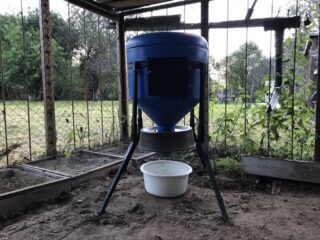
An obligatory piece of equipment for a chicken coop is a feeder. They are often made with their own hands from plastic items for various purposes or wood.The former are suitable for dry and wet feed. It is better to put only dry in wooden troughs.
It is recommended to mount the feeders to the wall at a distance of 20-30 cm from the floor so that the birds do not rake the food with their feet. It is better if the trough has slightly curved edges. The dimensions of the structure depend on the number of birds: each must have free access to food.
Products must be regularly washed, cleaned and disinfected. Wet, aerated food is the cause of most diseases.
Drinking bowls
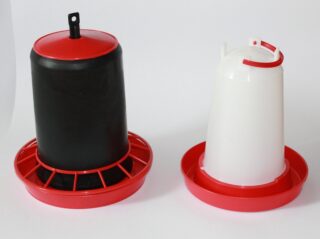
Drinking even in the smallest house is usually automated. A container with water is attached to the wall at a high height, 2 plastic pipes with a diameter of 10 cm are connected at a right angle. One end is fixed in the container, the other serves as a drinker. In this part of the pipe, longitudinal holes are cut with a jigsaw, which serve as drinkers.
Can be installed on the pipe drinking bowls with valves. They use less water.
The drinker and the feeder must be placed next to each other.
Swimming place
Chickens often fall prey to lice, flares, chewing lice and other pests. In addition to special products, ash baths are very helpful for birds.
On the street, chickens bathe in dust. In the hen house, for this, a box is equipped with an area of up to 1 m and a depth of up to 50 cm. If the house is small, the ash bath is placed directly under the nests. Pour dry sand, clay or wood ash crushed into dust into the container. If possible, finely ground sulfur is also added here - up to 200 g per ash bucket. It serves as an excellent natural disinfectant.
On the walking area for the ash bath, they dig a hole and put a deep trough in it.
Place for walking
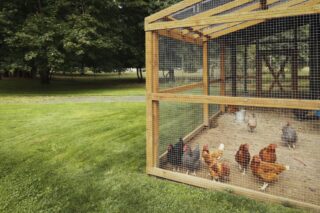
Walking is organized next to the chicken coop. A plot of at least 15 m² is fenced with a metal mesh. The height of the fence is not less than 1.5 m, and preferably more. In addition, during installation, it is recommended to deepen the net into the ground by 30–50 cm in order to prevent small predators from entering the hen house.
The need for cage keeping for layers arises when there are a large number of birds. The lack of walking and natural feed supplementation is compensated by the very high protein content of the food, frequent cleaning of cells and the introduction of stimulants into the feed.
Microclimate in the chicken coop
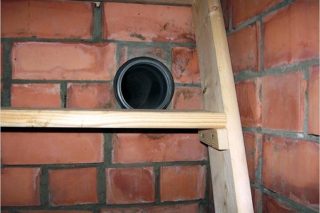
The device of the correct chicken coop implies the creation of optimal conditions for keeping birds.
- Temperatures from +5 to + 23ºС are allowed. At lower or higher temperatures, egg production decreases.
- Recommended humidity is 60–75%. This parameter is usually maintained easily, since chickens breathe intensively and release a lot of moisture with breathing. Usually, getting rid of excess moisture becomes a ventilation task.
- The rate of air exchange is up to 7 m³ per 1 kg of live weight. The body temperature of chickens is noticeably higher, they breathe more often and emit more carbon dioxide. Therefore, the air circulation in the house must be intensive.
- In order for the hen to lay a sufficient number of eggs, it is necessary to maintain a day of light for a duration of 12 hours. Artificial lighting is required.
These parameters are maintained with ventilation, heating and lighting.
Ventilation
In the poultry house, if it is not a building for 100 individuals, natural ventilation is provided. The scheme is simple. Two pipes - supply and exhaust - are installed vertically, as in the basement. The inflow is lowered to the floor - at a distance of 30-50 cm; the hood is mounted so that its inlet is under the ceiling. Both pipes are led out to the roof, and the height of the hood exceeds the height of the inlet by at least 50 cm.
It is recommended to cover the inlet with a metal mesh - it protects from debris. The outlet openings are covered with caps to prevent rain and snow from falling into the pipes.
Lighting
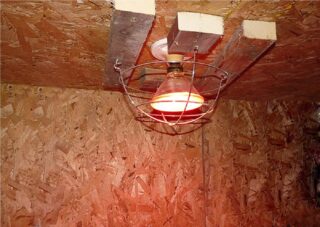
In order for the daylight hours in the winter chicken coop to reach 12-14 hours of the day, it is necessary to equip the lighting.Bright lamps are not needed: incandescent lamps of 60 W or their analogs of lower power are enough. Lamps are placed under the ceiling so that they evenly illuminate the chicken coop. An exception is the nests for layers. A pleasant twilight should reign in this area.
Lamps are protected with shades, metal grids, sockets and switches are waterproof and hidden under shields.
It is recommended to arrange automatic switching on and off. This is easy to do with a regular timer.
Heating
The temperature and humidity in the chicken coop are controlled by ventilation and heating systems. It is not difficult to equip the latter.
The chicken coop is heated by infrared lamps inside. They are placed not too high - no more than 50 cm from the floor, otherwise the heat will go to the ceiling, and the chickens will freeze. Models are chosen according to power. Distribute unevenly. Nests, for example, do not need to be heated, but the area with chickens needs heating and ventilation.
What else you should know
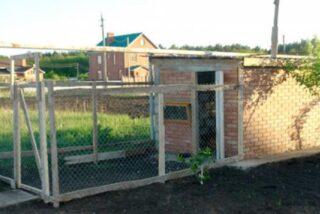
Most often, the poultry house is a frame structure sheathed with chipboard or OSV sheets. In the middle and northern latitudes, the walls are sheathed from the outside with insulation and sealed with the same materials.
A brick chicken coop is trimmed from the inside with clapboard or plywood. In this case, the heat insulator must be very carefully insulated, since the chickens love to peck at the walls and taste everything. It is advisable to whitewash the walls from the inside with lime whitewash and treat them with disinfectants once a year.
The thickness of the insulation layer, like the choice of material, depends on the weather conditions.
In harsh winters, you need to insulate the floor as well. To do this, a rough floor of a bar is laid on a concrete base, a layer of expanded clay, pellets is poured and covered with finishing boards on top. It is undesirable to use other materials, since chickens peck at the floors and can be poisoned by linoleum or laminate.
An important element of the arrangement is the litter. A 10 cm layer of sawdust, straw or peat ensures dryness and comfort in the chicken coop. The litter is changed as it gets dirty or damp.
Disinfection
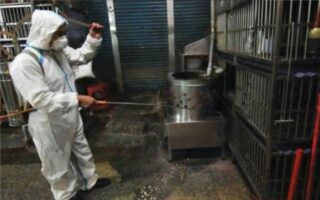
It is recommended to carry out disinfecting procedures once every 2 months. However, not all poultry breeders agree to do this laborious activity so often, so in fact disinfection is done once a year.
If the chickens are sick, regardless of the time of year and the time of the last procedure, disinfection is repeated.
Disinfection is carried out in warm, clear weather, having previously transferred the layers to an open enclosure. Most of the drugs are considered harmless to chickens, but farmers do not consider it necessary to take risks.
Disinfection is carried out in a protective suit, respirator and rubber gloves.
Before the procedure, the walls and floor are washed with warm water and vinegar. The lime-coated walls are washed completely and then a new layer of lime is applied.
The mixture for processing is chosen depending on which pathogen is being fought with. Use home remedies (formalin solution, bleach) and special ("Glutex", "Virotsid").
The area should be well ventilated for several hours before returning the birds to the coop.
If disinfection is carried out in winter, hens must be transferred to another room for a day.
To facilitate the decontamination and cleaning procedure, it is recommended to place plastic trays under the roost, where the bird droppings will be collected. The life of the litter can be extended by sprinkling sand on top of the straw. Birds are recommended to be treated with a parasite remedy before returning to the chicken coop.
Tips for arranging a chicken coop
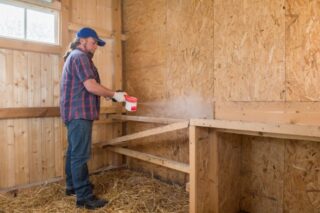
To make the house practical and convenient, the following are recommended:
- Make a window in the poultry house with an area of 1/10 of the area of the chicken coop. This provides natural light throughout the day and reduces electricity bills.
- A hole can be made in one of the walls to allow for litter change.
- Wooden parts in the chicken coop are treated with solutions from wood-boring insects and painted.
- A layer of lime is first placed on the floor under the bedding for disinfection. This prevents the growth of bacteria.
The arrangement of the hen house creates optimal conditions for the life of layers: constant temperature and humidity, a sufficiently long daylight hours, comfortable nests and perches.








